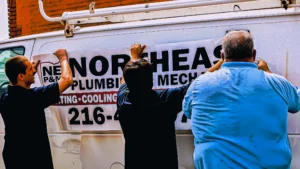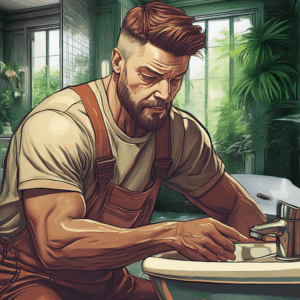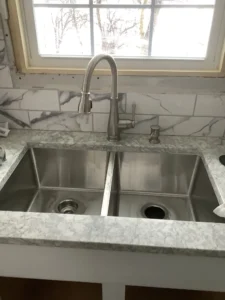
Reliable Plumbing Services for Cleveland, Lakewood & Greater Cleveland
Northeast Plumbing & Mechanical Reliable Plumbing Services for Cleveland, Lakewood & Greater Cleveland You Need
A dripping faucet or a slow drain can disrupt your day. While some plumbing problems need a professional touch, many common issues can be fixed with a little know-how. Learning to handle small repairs can save you time, money, and the headache of a plumbing emergency.
A slow or fully clogged drain is one of the most frequent household plumbing annoyances. Before you reach for harsh chemical drain cleaners, which can damage your pipes over time, try these mechanical solutions first.
A plunger is a simple yet powerful tool. For it to work, you need to create a proper seal.
For minor clogs, especially those caused by grease or soap scum, this classic home remedy can be surprisingly effective.
That constant drip, drip, drip is more than just annoying—it’s a waste of water and money. A small leak can waste thousands of gallons of water per year. Finding the source is the first step to fixing it.
A leaky faucet is often caused by a worn-out washer or O-ring. While replacing these parts can be a simple DIY project for those comfortable with tools, first confirm where the leak is coming from. Check the spout and the base of the faucet handles. Sometimes, simply tightening the packing nut at the base of the handle with a wrench can stop the drip.
A “silent” toilet leak can go unnoticed for months. Here’s a simple way to check for one:
Look under your sinks and around the base of your toilet for any signs of moisture, water stains, or mildew. A small puddle or dampness could indicate a loose connection. Try gently tightening the pipe fittings with a wrench, but be careful not to overtighten, which can cause more damage.
Your water heater works hard every day. A little regular maintenance can extend its life, improve its efficiency, and prevent unexpected breakdowns.
Most manufacturers recommend setting your water heater to 120°F (49°C). This temperature is hot enough for household needs but helps prevent scalding and reduces energy consumption. Settings higher than 120°F can accelerate mineral buildup and corrosion inside your tank.
The Temperature and Pressure (T&P) relief valve is a critical safety feature. It opens automatically to release excess pressure or heat. You should test it annually.
Sediment like sand, rust, and mineral deposits can build up at the bottom of your water heater tank over time. This buildup reduces efficiency and can cause damage. Flushing the tank once a year helps clear out this sediment. While some homeowners are comfortable doing this themselves, it involves handling hot water and connecting hoses, so many prefer to have a professional handle it.
DIY solutions are great for minor issues, but it’s important to know your limits. Attempting a complex repair without the right tools or experience can turn a small problem into a major, costly disaster.
You should always call a professional plumber if you experience:
Our team at Northeast Plumbing and Mechanical has the training, tools, and experience to handle any plumbing challenge, big or small. If you’ve tried these tips and are still stuck, or if you’re facing a problem that’s beyond a simple fix, don’t hesitate to get in touch. We’re here to provide reliable, professional service to keep your home’s plumbing

Northeast Plumbing & Mechanical Reliable Plumbing Services for Cleveland, Lakewood & Greater Cleveland You Need

Northeast Plumbing & Mechanical Why Northeast Plumbing is Cleveland’s Go-To Service Provider When a pipe

Northeast Plumbing & Mechanical DIY Plumbing Tips to Try Before You Call a Pro A

Northeast Plumbing & Mechanical NorthEast Plumbing: Cleveland’s Trusted Expert for Water Leaks in Your Home

Northeast Plumbing & Mechanical Plumbing is Cleveland’s Top Choice for Hot Water Tank Installation and

Northeast Plumbing & Mechanical NorthEast Plumbing: Your Trusted Partner for Home Plumbing in Cleveland and
Northeast Plumbing started with a simple idea. Show up, do it right, and earn the callback. No speeches, no slogans — just day one work ethic. We’ve been crawling through basements and digging through snow banks for over 30 years.
We show up when others won’t. We stay until it’s right. We treat your home with respect, your time like it’s precious, and your trust like it’s everything. Because to us, it is.
This is Northeast Plumbing, and we’re stronger than ever.
This place is great – In and out quickly, and the technicians, Dale and Chase, were respectful, exceptionally kind and even really funny too. They created a safe and welcoming environment and explained everything very simply, in a way that was easy to understand. I would definitely use this company again, as this was a great experience. They even squeezed us in for a same day appointment, which was great. You guys are the best – Thanks so much for your wonderful service!
Great experience, staff was professional, knowledgeable, and quick. I will be calling them for all my plumbing issues in the future!
Thank you Greg & Dale for being so awesome!
Dale, Jerry, and Josh came out to snake a backed up basement drain. They were very courteous and let me know everything they were doing to fix the issue which they resolved very quickly. I really appreciate the fast and friendly service.